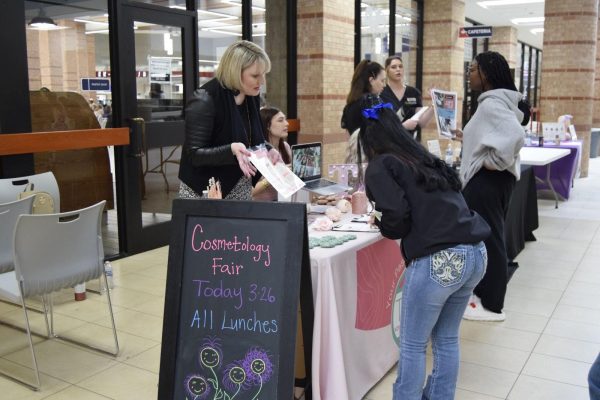Coughing up a lung
The Centers for Disease Control and Prevention (CDC.) has declared seven deaths and more than 530 confirmed cases of lung disease associated with the use of e-cigarettes.The number of cases is increasing, as people continue to puff away at their e-cigarettes, commonly known as a vape.
This stimulant is the new trend, especially among teenagers. E-cigarettes are intended to be used by adults (over 21) who are recovering from smoking actual cigarettes. However, in recent years, e-cigarettes have been developed differently — they’re smaller and there’s now hundreds of flavored juices that can be used with them.
Caroline Asimakos was in school one day when she suddenly started coughing. She was wheezing and coughing for what seemed like forever, until she started to cough up blood. Asimakos is terrified about what’s happening to her, and what’s responsible for her unknown diagnosis is her JUUL an e-cigarette that is shaped like a USB drive.)
Her Instagram posts were uploaded to Twitter, where the tweet now has over 75 thousand retweets.
“Honestly I had no idea my story would ever reach this much exposure,” the Candian high school student stated. “My initial intentions were just to warn my friends on my private page.”
In addition, Asimakos said she wants other teens to be aware that vaping isn’t as safe as it seems, and they should consider what could happen to them.
“…open [your] eyes and look at the [JUUL] box. There is an actual skull on it. It’s poison.”
Asimakos is from Canada and was introduced to vaping three years ago when she went to Florida to attend an academy.
“I guess everyone around me was [vaping.] I started ‘juuling’ every day since,” she wrote. “I would go through a pod a day to a day and a half. I was sharing with my friends, but it was mostly me.”
Like any teen, Asimakos said she didn’t believe anything could happen to her, until it did.
“I didn’t think it would happen to me either. I always thought there’s probably someone out there that’s been smoking longer than me and is fine. Then it happened to me, and it’s completely changed me for the worse,” she said
Asimakos said she has been in and out of the hospital three times now, and it’s been a month of constant coughing. She also gets frequent nose bleeds.
“I am going to run tests with the New Brunswick chief of medical… so hopefully I will figure out what’s happening and how to solve it.”
According to the CDC, there are indeed less toxic chemicals in e-cigarettes compared to actual cigarettes, but vapes still contain nicotine and other harmful chemicals.
Nicotine is a stimulant drug, and can alter physiological and/or nervous activity in the body. Because nicotine is a stimulant drug, it is also highly addictive.
As reported in a presentation of International Symposium on Nicotine, nicotine is as addictive when compared to other stimulants like heroin and cocaine,. Moreover, according to the Truth Initiative, cigarettes and e-cigarettes will result in the same amount of nicotine intake over time, meaning that e-cigarettes are not better than traditional cigarettes.
As claimed by the National Institutes of Health, it has been proven that nicotine is a gateway drug, and over 90 percent of adult cocaine users between the ages of 18 and 34 have smoked cigarettes before they began using cocaine.
As specified by the CDC, nicotine can halt brain development for teenagers, and also lead to lung disease. Furthermore, as stated by the Truth Initiative, JUUL pods contain as much nicotine as a pack of 20 cigarettes.
Nicotine isn’t the only damaging aspect in e-cigarettes; the CDC discovered that they discharge aerosol as well. E-cigarette aerosol is dangerous and not water vapor, contradictory to common belief. Users breathe in and exhale aerosol from e-cigarettes and vapes, which contain not only nicotine, but also extremely harmful substances.
As specified by the Truth Initiative, these harmful substances include lead, nickel, silver, formaldehyde, and other chemicals that are linked to cancer and central nervous system problems.
Also, according to the CDC, the flavoring associated with JUUL linked with other e-cigarettes contains diacetyl, a chemical linked to serious lung disease.
On top of the dangerous chemicals contained in e-cigarettes, proven by the Truth Initiative, companies falsify ingredient lists that have been proven true through studies have found mislabeling to be a common issue for e-cigarettes, meaning the nicotine levels labeled are not always 100 percent correct.
Consequently, the Trump administration announced Sep. 11 that they would attempt to ban all flavored vaping products. Trump alludes that e-cigarette companies are advertising with flavorings to appeal to teenagers, which he says needs to be stopped.
“I definitely think e-cigarettes are marketed to teens. Why else would they have flavors and have them ‘disguised’ as USB’s?” Asimakos commented.
Tryston Zohfeld is a typical 17-year-old teenager. He went to school at Weatherford High School in North Texas. He was rushed to the hospital on July 26 due to throwing up and coughing profusely. It was at the hospital where it was found out that Zohfeld’s lungs were blocked. He was medically induced into a coma, with his condition getting worse.
In addition, the tests for certain lung diseases were all coming back negative. It was discovered that Zohfeld had been vaping since eighth grade. The many chemicals that e-cigarettes contain had made his lungs so inflamed that his respiratory system was failing. The years of vaping had caught up to him, so much so, that the chemicals scarred his lungs. Zohfeld was in a coma for 10 days and had lost 25 pounds. He vowed to never vape again, as they’re not as safe as warranted.
The Eagle Angle conducted an anonymous survey to collect data from students about vaping.
“I [vape] because it gives me something to do to occupy my boredom,” one student wrote. “It’s like chewing gum for me in the sense that it helps calm me down and keep me focused on things that I need to do.”
Another student wrote, “I was pressured into vaping by my peers. I regret it.”
From the data collected, there are students who believe vaping is dangerous and advise others not to do it.
“It’s so disheartening and discouraging that our generation is the one that has to face the consequences of this addiction,” a student wrote.
On the flip side, some students say vaping shouldn’t be entirely blamed for the many cases of lung disease.
“I believe people are quick to antagonize anything new… stop treating vaping like the plague…” a student wrote.
Additionally, some students emphasized that the school shouldn’t be punishing students, but attempt to help them instead.
One student wrote, “instead of kicking kids out of school and throwing them into Dillard, create addiction sessions, possibly, and try assisting, not penalizing.”
“We need more education about it in schools so people don’t do it,” another student wrote.
However, the answers to why do teens vape, most replied that they vape because of anxiety and/or stress.
In survey comments, one student wrote that “it helps my anxiety,” and another wrote, “it removes some of the debilitating stress of school and other activities.”
Asimakos continually emphasized that she “Truly never thought I’d be in a situation like this, coughing up crazy amounts of blood. It had me shook to my core. It was a wake up call for me, and I am grateful for it. I have been able to reach millions of people and warn them of the dangers of vaping.”

Senior Sophia Forrester likes listening to Ribs or Supercut by Lorde and watching an excessive amount of Disney movies. She plans to pursue her data science...







